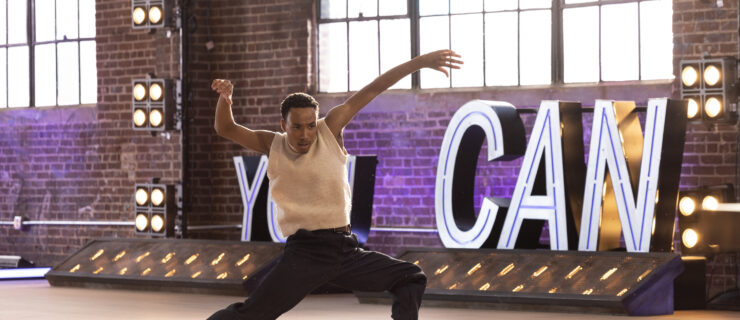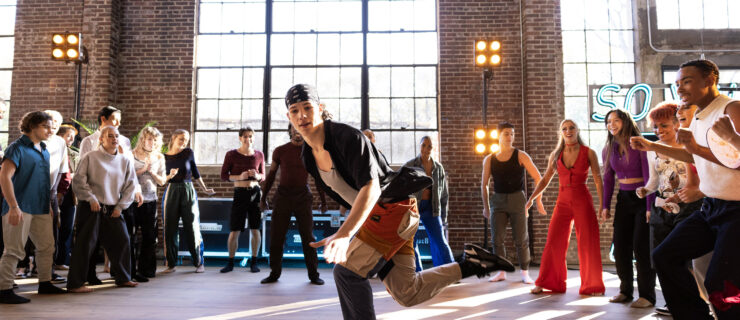Cross-Training 2.0
George Balanchine’s Agon is one of the hardest ballets for dancers to learn, thanks mostly to its incredibly complex score. Igor Stravinsky’s tricky phrasing and frequent tempo changes can baffle even experienced dancers. But at San Francisco Ballet, corps member Shannon Marie Rugani has no problem following Stravinsky’s music. Why? Because she plays the piano, drums, ukulele, guitar and harmonica, in addition to composing her own pieces of music.
Shannon Marie Rugani in West Side Story Suite with San Francisco Ballet (Chris Hardy, courtesy San Francisco Ballet)
You don’t have to be a virtuoso like Rugani to benefit from studying music. Reading notes, playing an instrument, familiarizing yourself with the musical canon and learning music history can change the way you interpret choreography and help you stand out from dancers who don’t have a musical background. In many ways, studying music is as important as the cross-training you do at the gym—you’re just strengthening your musical mind instead of your body.
Musicality vs. Musicianship
Everyone knows dancers should be musical, but sometimes that quality is hard to define. In his classes, Jeffrey Middleton, music instructor at the School of American Ballet, helps dancers improve their musicality by developing their musicianship. “Musicality in a dancer means having sensitivity to the rhythm, line and mood of a piece,” Middleton explains. “Musicianship is about having a good ear, learning to play an instrument and developing a knowledge of music.”
The first part of his class takes place at the piano, where students learn to count, read and try to make music. The second part is general music history—studying pieces that were written specifically for dance or used for choreography. Though his classes target ballet students, Middleton says that music lessons are beneficial for all dancers. “It’s about becoming a better listener and putting music in a particular context,” he says.
Jeffrey Middleton leads music class at the School of American Ballet (photo by Rosalie O’Connor)
The Benefits of Musical Training
Studying music gives you a better idea of rhythm and phrasing. It helps you distinguish elongated notes from staccato (short and fast) notes. You’ll learn to hear when something is softer or louder and to listen to the silence between notes. “All of that gets translated into your body,” says Daisha Graf, a commercial dancer and recording artist who studied piano growing up. Musical knowledge, she says, also helps you pick up choreography faster: The more you can hear, the more easily you can associate steps with sounds.
Hearing different aspects of the music, like flowing melodies or pulsing undercurrents, allows you to shape your movements to match the score, too. “Everything has to be connected, or the people watching aren’t going to be inspired or moved,” says Leah Faircloth, a 17-year-old competition dancer at CC & Co. Dance Complex in North Carolina. Leah says that her training in piano and cello has made it easier for her to break down rhythms for dance, especially in tap routines. “I have an advantage for learning timing and dynamics,” she says. “That lets me just dive into the choreography, instead of thinking about what comes when.”
At Central Pennsylvania Youth Ballet, founding artistic director Marcia Dale Weary notices that her most musical students play an instrument. Their exposure to classical music studies at home or at school affects the way they express themselves in the studio. “I see that they dance from their souls,” she says, “that they are able to sing the music.”
Studying on Your Own
If music classes are beyond your financial or geographic reach, there are other ways to improve your musicianship. Dale Weary suggests seeking out classical music recordings and listening to them at home or in the car. “Classical is much more complex than pop music—you have to listen to it over and over,” she says. Get familiar with the syncopated work of Scott Joplin and George Gershwin, as well as that of classical composers like Brahms, Beethoven and Rachmaninoff. World music, especially polyrhythmic African music, is helpful, too. “Many styles focus on different rhythms, and you can learn from each one,” Graf says. “Go beyond what you’re used to hearing.”
Central Pennsylvania Youth Ballet’s artistic director Marcia Dale Weary teaching class (photo by Rosalie O’Connor)
Rugani recommends YouTubing music theory videos. “There are so many videos and teachers to choose from,” she says. You can even pick up a cheap keyboard and a simple theory book so that you can practice. Piano apps for tablets and smartphones can also be helpful. Feeling ambitious? If you can swing it, Middleton suggests getting a drum set. “Drums are the best thing to explore if you’re a dancer,” he says—they’re great tools when it comes to understanding rhythm and counts.
Try not to get frustrated if you don’t notice an improvement in your musicality right away. “Musical development is very slow, and sometimes you feel like nothing is happening,” says Middleton. “But over the long term, it becomes a part of your growth. Eventually, the musical side of dance will come naturally to you.”



